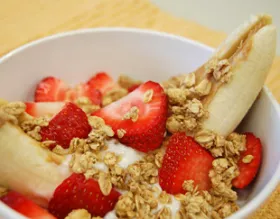Apple Nachos
a c. dried, unsweetened cranberries or raisins
¼ c. sliced or whole almonds, unsalted
2 Tbsp. hulled, unsalted sunflower seeds
3 medium apples (red and/or green), cored and thinly sliced (about 12 pieces per apple)
1 to 2 tsp. lemon juice
2 Tbsp. hot water (extra if needed)
¼ c. smooth peanut butter*
1 Tbsp. honey
In a small bowl, combine dried cranberries/raisins, almonds and sunflower seeds. Core each apple and thinly slice into about 12 pieces each. Layer half of the apples onto a large plate or platter. If the apple slices will be sitting out for a while, sprinkle with lemon juice to prevent browning. Using a microwave oven or teapot, bring 2 tablespoons of water to a boil. In a small bowl, combine hot water, peanut butter and honey. Use a spoon to stir until mixture is smooth. Use a spoon to drizzle the peanut butter mixture over the plated apple slices; sprinkle with half the cranberry mixture. Layer the remaining apples on top and repeat with remaining peanut butter and cranberry mixture. Serve.
Makes eight servings. Each serving has 167 calories, 7.4 g fat, 4 g protein, 22 g carbohydrate, 4 g fiber and 66 mg sodium.
*Nutrition information is calculated with reduced fat peanut butter.
Source: This recipe is adapted from the American Heart Association, www.heart.org



